SWASHBUCKLING SIRENS OF THE SILENT SCREEN
(SWORDSWOMEN OF WESTERN CINEMA PART I)
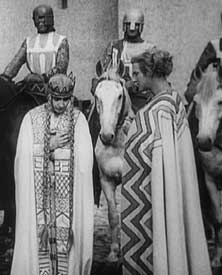 Fritz Lang's two-part epic Die Nibelungen (1924) was scripted by his wife, Thea von Harbou, who also wrote the novel & screenplay for Metropolis (1927) with its fantastic female robot, & other of Lang's most famous films.
Fritz Lang's two-part epic Die Nibelungen (1924) was scripted by his wife, Thea von Harbou, who also wrote the novel & screenplay for Metropolis (1927) with its fantastic female robot, & other of Lang's most famous films.
The films have, as a result, an almost feminist streak throughout. Her script for Die Nibelungen follows not the Wagnerian opera version (which drew, curiously, from Scandinavian rather than Germanic versions) but from the medieval Austrian/German manuscripts which are believed by a few scholars to be the work of a nun. (Textual evidence that a nun wrote the original tale is its obsession with domestic details, & neglect of important fights & battles.)
In Part I of the film, Brunhild (Hanna Ralph) is the mortal queen of an Amazon country, a woman who has no equal among men. She has promised to wed only the man who can defeat her on the gaming range. Even mighty Siegfried (Paul Richter) would be no match for her without the magic of the dragon's blood, in which he bathed.
Siegfried ultimately defeats Brunhild. However, she is defeated not by superior military expertise, not in any honorable fashion, but by trickery during tests of leaping, boulder tossing, & lance fighting.
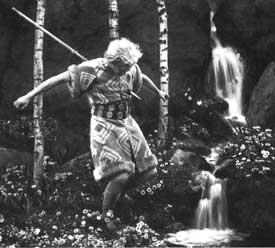 Although Brunhild suspects the treachery by which Siegfried was aided, her own honor is too great for her to go back on her promise. Therefore she marries the weak man & is taken away to his country, where she becomes a slavish, bitter, ultimately doomed woman. Although Brunhild suspects the treachery by which Siegfried was aided, her own honor is too great for her to go back on her promise. Therefore she marries the weak man & is taken away to his country, where she becomes a slavish, bitter, ultimately doomed woman.
Part Two, Kriemhild's Revenge (1924), can be considered a separate film, although much of the heroine's motivation is shown in Part One. Kriemhild (Margarete Schon) isn't quite the martial figure we have in Brunhild, but she is single-minded in her quest of a vengeance to be achieved by intrigue & by military planning.
Kriemhild's mortal enemy is Hagen (Hans Adalbert Schlettow) who not only slew Siegfried, but robbed the widow of her fortune as well. At the time the medieval manuscripts that contain these stories were being written, convents had been disenfranchised by quasi-legal means, denied the funds of their estates. The whole of Die Nibelungenlied can, then, be viewed as these nuns' commentary & criticism of their own contemporary history.
Von Harbou's script does not lose this element, either. In the final scene, the widowed & financially ruined Kriemhild takes up sword & kills the ruthless Hagen with her own hands!
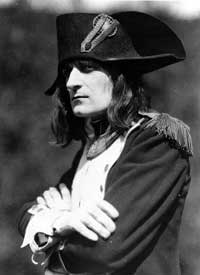 Another silent epic was made in France by Abel Gance. Due to politics, finances, & a changing film industry, it was not edited into a final version until the 1970s. Sound was added &, surprisingly, the sound version works pretty well; it does not seem dubbed. But much footage had been lost to time. To make a coherent story, new footage was added, & this sometimes distracts with its more newer appearance. We forgive it because Abel Gance in his old age oversaw the revamping personally & shot the new footage. Another silent epic was made in France by Abel Gance. Due to politics, finances, & a changing film industry, it was not edited into a final version until the 1970s. Sound was added &, surprisingly, the sound version works pretty well; it does not seem dubbed. But much footage had been lost to time. To make a coherent story, new footage was added, & this sometimes distracts with its more newer appearance. We forgive it because Abel Gance in his old age oversaw the revamping personally & shot the new footage.
This film is called Bonaparte; aka, Bonaparte et la Revolution (1971), starring Albert Dieudonne who remains to this day cinema's most appealing & realistic Napoleon. This was not the first time Gance had tinkered with his masterpiece, which was re-released with its first "sounded' treatment in 1934 as Napoleon Bonaparte.
A longer version is an actual restoration without the imposition of sound dialogue. This is the authentic silent film treasure from 1927. It has a couple different versions, one with a new & often grating score by Carmine Coppola (1981).
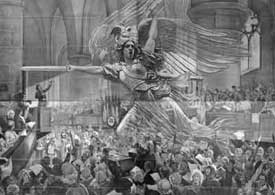 The other & vastly to be preferred longest version (exceeding five hours!) has a score by Carl Davies (1980, but the longest version was not released until 2000). This latter version is occasionally shown in city orchestra houses with the score performed live, for the most complete possible recreation of the ultimate silent film experience as it existed in days before the loss of the oldest movie palaces. The other & vastly to be preferred longest version (exceeding five hours!) has a score by Carl Davies (1980, but the longest version was not released until 2000). This latter version is occasionally shown in city orchestra houses with the score performed live, for the most complete possible recreation of the ultimate silent film experience as it existed in days before the loss of the oldest movie palaces.
It is a gorgeous romanticism of Napoleon's early career, when he was seen as a revolutionary rather than a tyrant. This is one of the most important films in all film history & many essays could be written about it (& have been). But here I want to highlight the inclusion of a side-character, called "the Amazon of France."
She is not given an on-stage battle scene, but she's always shown with sword in hand, implying her capabilities. This figure was Anne-Josephe Theroigne de Mericourt (1762-1817), a real-life swordswoman of the French Revolution, who organized a brigade of women warriors who were notably bloodthirsty. She is played by Abel Gance's wife.
In addition to Theroigne, we are also treated to a vision of the "Spirit of the Revolution" who makes a guest appearance -- the personification of the Revolution always being, in tradition, a spectacular Amazon known popularly as La Marseillaise, & played here by a famous cabaret performer, Damla.
In 1916, Intolerance by D.W. Griffith premiered to few accolades. It has had many modern showings across the country, often at sound speed to accommodate a new score, causing the characters & action to be viewed quite a bit faster than is reasonable. When seen at its proper film speed, it is possible to appreciate the fabulous sets & superb acting more fully.
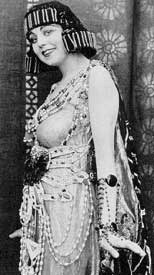 It is really four films at once: one story, damning women's political gains, is contemporary with right-wing Griffith. Another is set in 16th-century France & makes hysterical contrasts between modern politically motivated women & the manipulative Catherine d'Medici, who wielded power menacingly. These two sections taken together could be retitled Intolerance....of Women, & underscore the hypocrisy of Griffith of all people committing to film a meditation on "Intolerance," given that his most famous work will always be Birth of a Nation (1915) glorifying the Ku Klux Klan. It is really four films at once: one story, damning women's political gains, is contemporary with right-wing Griffith. Another is set in 16th-century France & makes hysterical contrasts between modern politically motivated women & the manipulative Catherine d'Medici, who wielded power menacingly. These two sections taken together could be retitled Intolerance....of Women, & underscore the hypocrisy of Griffith of all people committing to film a meditation on "Intolerance," given that his most famous work will always be Birth of a Nation (1915) glorifying the Ku Klux Klan.
The third of the four independent pieces is an utterly uninspiring story of Christ; & most notably, we have the tale of the Fall of Babylon, which remains one of the most spectacular pieces of cinema of all time.
It is this last tale which includes, as its central character, a young woman who is a skilled archer & charioteer. A curious film, Intolerance really was intended to change the tide of women's inevitable right to vote, of which Griffith disapproved.
Paralleling his treatment of blacks in Birth of a Nation, Intolerance is grandly romantic in its portrait of a passive "Little Dear One" in the modern tale & in the image of the beautiful queen of Babylon, who has no political aspirations save to dote on her king & husband. Women outside roles deemed "natural" are, by contrast, the villains -- with one startling exception, the female warrior who would seem to contradict everything else Griffith held to be sacred.
The exception is more than just startling, given Griffith's political intentions. Although we are given to understand that the horrors of 16th-century France are the fault of a woman, & that the injustices in America in the first decade of the 20th century were the fault of women leaving their proper places, we are simultaneously shown that Babylon might yet rule the East if the bravery of only one warrior woman -- the Mountain Girl (Constance Talmadge, who also plays Marguerite de Valois in Medici episode) -- had been acknowledged & her warnings heard.
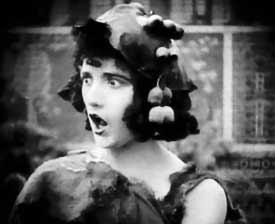 How did Griffith, that paragon of racism & sexism, devise such an exciting & active heroine as the Mountain Girl? Since Griffith drew on Herodotus for his story, perhaps he could not ignore the exploits of the Amazon that Herodotus repeatedly outlines in the Histories. (Cyrus the Great, a character in Intolerance, was, according to Herodotus, slain by a martial queen named Tomyris on the field of battle.) How did Griffith, that paragon of racism & sexism, devise such an exciting & active heroine as the Mountain Girl? Since Griffith drew on Herodotus for his story, perhaps he could not ignore the exploits of the Amazon that Herodotus repeatedly outlines in the Histories. (Cyrus the Great, a character in Intolerance, was, according to Herodotus, slain by a martial queen named Tomyris on the field of battle.)
Griffith may have been unaware of the way this ancient character contradicted his modern political statements, & been interested, instead, in the cinematic possibilities of a woman warrior. Or it might have been that Griffith himself was unsure of his own stand regarding women outside their so-called proper roles.
Whatever the motivation & origin of the Mountain Girl, she is a stronger woman warrior than any supposedly liberal directors ever devised. Although the Mountain Girl is ineffective in saving her beloved king & Babylon, she at least can & does take a stand & fights to a heroic death. Her battle scenes are rarely equaled by modern filmmakers.
copyright © by Paghat the Ratgirl
|
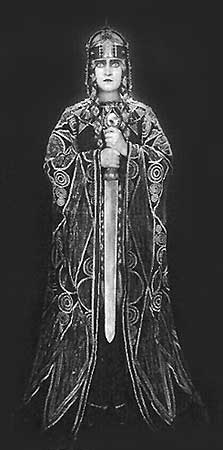

 Although Brunhild suspects the treachery by which Siegfried was aided, her own honor is too great for her to go back on her promise. Therefore she marries the weak man & is taken away to his country, where she becomes a slavish, bitter, ultimately doomed woman.
Although Brunhild suspects the treachery by which Siegfried was aided, her own honor is too great for her to go back on her promise. Therefore she marries the weak man & is taken away to his country, where she becomes a slavish, bitter, ultimately doomed woman.
 The other & vastly to be preferred longest version (exceeding five hours!) has a score by Carl Davies (1980, but the longest version was not released until 2000). This latter version is occasionally shown in city orchestra houses with the score performed live, for the most complete possible recreation of the ultimate silent film experience as it existed in days before the loss of the oldest movie palaces.
The other & vastly to be preferred longest version (exceeding five hours!) has a score by Carl Davies (1980, but the longest version was not released until 2000). This latter version is occasionally shown in city orchestra houses with the score performed live, for the most complete possible recreation of the ultimate silent film experience as it existed in days before the loss of the oldest movie palaces. It is really four films at once: one story, damning women's political gains, is contemporary with right-wing Griffith. Another is set in 16th-century France & makes hysterical contrasts between modern politically motivated women & the manipulative Catherine d'Medici, who wielded power menacingly. These two sections taken together could be retitled Intolerance....of Women, & underscore the hypocrisy of Griffith of all people committing to film a meditation on "Intolerance," given that his most famous work will always be Birth of a Nation (1915) glorifying the Ku Klux Klan.
It is really four films at once: one story, damning women's political gains, is contemporary with right-wing Griffith. Another is set in 16th-century France & makes hysterical contrasts between modern politically motivated women & the manipulative Catherine d'Medici, who wielded power menacingly. These two sections taken together could be retitled Intolerance....of Women, & underscore the hypocrisy of Griffith of all people committing to film a meditation on "Intolerance," given that his most famous work will always be Birth of a Nation (1915) glorifying the Ku Klux Klan. How did Griffith, that paragon of racism & sexism, devise such an exciting & active heroine as the Mountain Girl? Since Griffith drew on Herodotus for his story, perhaps he could not ignore the exploits of the Amazon that Herodotus repeatedly outlines in the Histories. (Cyrus the Great, a character in Intolerance, was, according to Herodotus, slain by a martial queen named Tomyris on the field of battle.)
How did Griffith, that paragon of racism & sexism, devise such an exciting & active heroine as the Mountain Girl? Since Griffith drew on Herodotus for his story, perhaps he could not ignore the exploits of the Amazon that Herodotus repeatedly outlines in the Histories. (Cyrus the Great, a character in Intolerance, was, according to Herodotus, slain by a martial queen named Tomyris on the field of battle.)